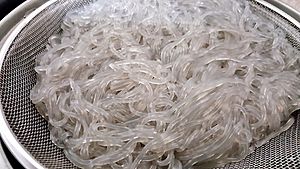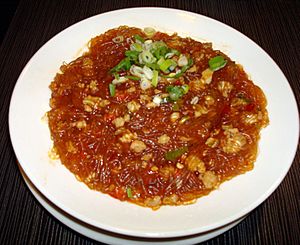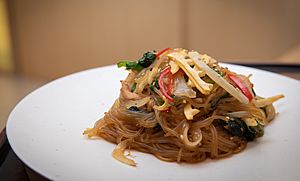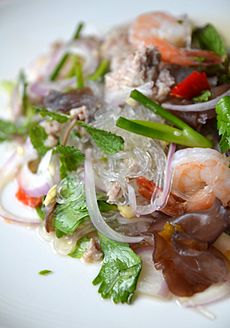Cellophane noodles facts for kids

Cooked cellophane noodles
|
|
| Alternative names | Glass noodles |
|---|---|
| Type | Noodles |
| Place of origin | China |
| Region or state | East Asia, Southeast Asia |
| Associated national cuisine | China, Indonesia, Japan, Korea, Malaysia, Philippines, Samoa, Thailand, United States, Vietnam, Myanmar and Taiwan |
| Main ingredients | Starch (from mung beans, yams, potatoes, cassava, canna, or batata), water |
| Regional name | |
|---|---|
| Chinese name | |
| Traditional Chinese | 粉絲/粉條 |
| Simplified Chinese | 粉丝/粉条 |
| Literal meaning | flour thread |
| Hanyu Pinyin | fěnsī |
| Wade–Giles | fên3-ssŭ1 |
| Yale Romanization | fán sī |
| Jyutping | fan2 si1 |
| Chinese name (Taiwan) | |
| Chinese | 冬粉 |
| Literal meaning | winter flour |
| Hanyu Pinyin | dōngfěn |
| Bopomofo | ㄉㄨㄥㄈㄣˇ |
| Wade–Giles | tung1-fên3 |
| Hokkien POJ | tang-hún |
| Burmese name | |
| Burmese | ကြာဆံ |
| Vietnamese name | |
| Vietnamese alphabet | miến / bún tàu |
| Hán-Nôm | 麪 / 𡅊艚 |
| Literal meaning | noodle / Chinese vermicelli |
| Thai name | |
| Thai | วุ้นเส้น / เส้นแกงร้อน / ตังหน |
| RTGS | wun sen / sen kaeng ron / tung hon |
| Korean name | |
| Hangul | 당면 |
| Hanja | 唐麵 |
| Literal meaning | Tang noodle |
| Revised Romanization | dangmyeon |
| McCune–Reischauer | tangmyŏn |
| North Korean name | |
| Chosŏn'gŭl | 분탕 |
| Hancha | 粉湯 |
| Literal meaning | flour soup |
| Revised Romanization | buntang |
| McCune–Reischauer | punt'ang |
| Japanese name | |
| Kanji | 春雨 |
| Kana | はるさめ |
| Revised Hepburn | harusame |
| Malay name | |
| Malay | suhun |
| Indonesian name | |
| Indonesian | sohun |
| Filipino name | |
| Tagalog | sotanghon |
Cellophane noodles, also known as glass noodles, are a special type of transparent noodle. They get their name because they look clear like cellophane or glass when cooked.
These noodles are usually made from different kinds of starch, like mung bean starch, potato starch, or sweet potato starch. They are often sold dried. Before you cook them, you usually soak them in water to make them soft. Then, they can be added to soups, stir-fried dishes, or even spring rolls.
It's easy to confuse cellophane noodles with rice vermicelli. But remember, rice vermicelli are made from rice and are white, while cellophane noodles are clear after cooking.
Contents
Different Kinds of Cellophane Noodles
Cellophane noodles can be made from many different starches. In China, they are often made from mung bean starch or sweet potato starch.
- Chinese noodles made from mung bean starch are called Chinese vermicelli or bean threads.
- Those made from sweet potato starch are known as Fentiao or Hongshufen.
- In Korea, thicker noodles made with sweet potato starch are called sweet potato noodles or dangmyeon.
You can find cellophane noodles in different thicknesses. Some are wide and flat, like sheets, and are called mung bean sheets in China. In Korea, flat sweet potato noodles are called napjak-dangmyeon.
-
Dried Chinese vermicelli made with mung bean starch
-
Dried Chinese fentiao or Hongshufen made with sweet potato starch
-
Sì chuān suān là fěn (Hot and sour noodles) made with Fensi or Hongshufen
-
Dōng běi dà lā pí made with Chinese mung bean sheets
-
Dried Korean dangmyeon made with sweet potato starch
-
Napjak-dangmyeon in jjimdak
Where They Are Made
In China, a town called Zhangxing in Zhaoyuan, Shandong province, is a main place where cellophane noodles are made. Historically, these noodles were shipped from the port of Longkou. Because of this, they are often known and sold as Longkou fensi.
How They Are Used Around the World
Cellophane noodles are a popular ingredient in many cuisines, especially in Asia.
East Asia
China

In China, cellophane noodles are called fěnsī (Chinese: 粉絲, meaning "noodle thread") or fěntiáo (Chinese: 粉條, meaning "noodle strip"). They are often used in stir-fries, soups, and especially in hot pots. They can also be added to the fillings of Chinese dumplings (jiaozi) and flatbreads (bing), especially in vegetarian versions.
Thicker cellophane noodles are sometimes used in vegetarian soups to look like shark's fin. In China's northeast, thicker noodles are used in stir-fries and cold salads. A famous dish from Sichuan is called ants climbing a tree. It's made with cellophane noodles and a spicy ground pork sauce.
In Tibetan cuisine, glass noodles are called phing or fing. They are used in soups, pork curry, or with mushrooms.
Japan
In Japanese cuisine, these noodles are called harusame (春雨), which means "spring rain." Japanese harusame are usually made from potato starch. They are often used in salads or as an ingredient in hot pot dishes. They are also used in Japanese versions of Chinese and Korean dishes. You might also hear of Shirataki noodles, which are clear Japanese noodles made from the konjac yam.
Korea

In Korean cuisine, glass noodles are usually made from sweet potato starch and are called dangmyeon (Hangul: 당면). They are commonly stir-fried with beef and vegetables, and seasoned with soy sauce and sugar. This popular dish is called japchae (hangul: 잡채). Uncooked dangmyeon noodles are usually thick and brownish-gray.
South Asia
India
In India, glass noodles are called falooda. They are often served on top of kulfi, a traditional Indian ice cream. These noodles are usually made from arrowroot starch. They don't have much flavor on their own, which makes them a nice contrast to the sweet kulfi. You can find kulfi and falooda at many food stalls across India.
Southeast Asia
Indonesia
In Indonesian cuisine, cellophane noodles are called soun or suun. They are often eaten with dishes like bakso (meatball soup), tekwan (fish cake soup), and soto (traditional soup). In some areas, soun is made from aren starch.
Malaysia
In Malaysia, they are known as tanghoon (冬粉). People sometimes confuse them with bihun (米粉), which are rice vermicelli. They are also sometimes called suhun or suhoon.
Myanmar (Burma)
In Myanmar, cellophane noodles are called kyazan (ကြာဆံ), which means "lotus thread." More specifically, they are called pe kyazan (ပဲကြာဆံ), meaning "bean lotus thread," because they are usually made from mung bean flour. Another type, hsan kyazan (ဆန်ကြာဆံ), refers to rice vermicelli.
Kyazan is a main ingredient in a Burmese soup called kya zan hinga and is also used in Burmese salads.
Philippines
In Filipino cuisine, these noodles are called sotanghon. This name comes from a popular dish also called sotanghon, which is made with chicken and wood ear mushrooms. Like in Malaysia, people sometimes confuse them with rice vermicelli, which are called bihon in the Philippines.
Thailand

In Thai cuisine, glass noodles are called wun sen (Thai: วุ้นเส้น). They are often mixed with pork and shrimp in a spicy salad called yam wun sen (Thai: ยำวุ้นเส้น). They are also used in stir-fried dishes like phat wun sen (Thai: ผัดวุ้นเส้น).
Vietnam
In Vietnamese cuisine, there are two kinds of cellophane noodles. One is called bún tàu or bún tào, made from mung bean starch. The other is called miến or miến dong, made from canna starch. These noodles are key ingredients in dishes like miến gà, miến lươn, miến măng vịt, and miến cua. Sometimes, these noodles are confused with rice vermicelli (called bún in Vietnamese).
Polynesia
French Polynesia
In French Polynesia, cellophane noodles are known as vermicelle de soja. They were brought to the islands by Chinese workers in the 1800s. They are most often used in maʻa tinito, a dish with cellophane noodles, pork, beans, and cooked vegetables.
Hawaii
In Hawaii, where Asian cultures have greatly influenced the food, cellophane noodles are called long rice. This name might come from how the noodles are made, by pushing the starch through a special tool. They are often used in chicken long rice, a dish of cellophane noodles in chicken broth, commonly served at Hawaiian parties called luaus.
Samoa
Glass noodles arrived in Samoa with Chinese workers in the early 1900s. They became known as "lialia", a Samoan word meaning "to twirl," because of how people twirl the noodles with chopsticks. A popular dish called sapasui (which comes from the Chinese "chop suey") is often served at social gatherings. Sapasui is a soupy dish with boiled glass noodles, braised pork, beef, or chicken, and chopped vegetables. It's similar to Hawaiian "long rice."
See also
 In Spanish: Fideo celofán para niños
In Spanish: Fideo celofán para niños








